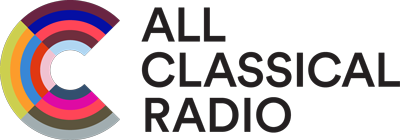Opening: Where We Live theme music:
(a small group of trumpets plays a short simple melody)
ANDREA MURRAY:
This is Where We Live, a regular feature on All Classical Portland that spotlights artists and organizations exploring the intersections of arts and social issues. I’m Andrea Murray
(sound of someone playing a simple piano melody)
MURRAY:
This, obviously, is the sound of a piano. A pretty typical upright one, if you’re trying to picture it in your mind. But there’s a feature on this particular piano that you can’t experience on the radio. Just above the keyboard, on the outside of the panel that covers the strings, a digital screen displays washes of soft color, undulating and scrolling upward, as if someone had animated an impressionist watercolor. Synchronized to the piano sound, it’s designed to give Deaf and Hard-of-Hearing people a -visual- experience of the music.
The ”See Sound Pian” was created by a Portland not-for-profit organization called “CymaSpace.”
MAN:
Our goal is to make performing arts more engaging and accessible.
MURRAY:
That’s the founder of CymaSpace,Myles DeBastion, speaking through an ASL interpreter in an online video.
DEBASTION:
We do this by incorporating all of the senses.
MURRAY:
DeBastion is a Deaf musician and artist, deeply involved in what’s known as Cymatics –the science of turning sound waves into visual and tactile representations. And that piano is just the beginning…
(Quiet ambient electronic music, from a CymaSpace YouTube video about their programs)
MURRAY:
Located in an old warehouse by the railroad tracks, in Portland’s Southeast Industrial District CymaSpace serves as an accessible performance venue and community space, an advocacy and education group… But it’s their technology lab that’s at the heart of CymaSpace’s mission.
(man’s voice, sound of him demonstrating a drum with lights attached etc)
That’s where their Deaf-led staff and volunteers develop develop new ways of digitally correlating the frequencies and timbres and volumes of soundwaves to specific hues on the color spectrum. The hues can be made to appear in any number of ways, including coruscating sunbursts, overlapping lines, and pulsating geometric forms…. ‘
(sound of someone clapping and singing)
In this case, singing and clapping appear as just a handful of colors travelling through a clear plastic rope. But sound-reactive technology can also appear as a sculpture, a piece of furniture, or – and CymaSpace hopes this will become the standard soon -– the walls of concert halls and theaters.
(quiet background noise of people murmuring, someone playing xylophone, etc.)
MAN:
It’s up to us to create the environment where no one else can build it. They don’t know what it’s like to be deaf. They don’t know what it’s like to feel the music at a deeper level. That’s our job.
MURRAY:
Nate Hergert, is CymaSpace’s head of community engagement. During a tour at a recent open house, I was able to interact with him easily not because I’ve finally gotten around to learning American Sign language – but because he has cochlear implants. He can use when he needs to interact with the hearing world. Part of his work involves helping develop devices that translate sound into sensation…allowing audiences to feel music vibrating through specially designed flooring, seating.….even wearable devices
Hergert lets me try on a device that looks like a life vest that makes a Chopin nocturne tangible.
(sound of Nate at open house, helping Andrea on with the vest.)
HERGERT:
Got it? …okay, now the headphones….
MURRAY:
….Oh wow! I can feel these vibrations all over my back……And the louder the music the more intense the vibration
(voices fade as the sound of lowkey electronic music fades in…recorded at a CymaSpace event.)
MURRAY:
Deaf and hearing Portlanders get to experience sound as vibration and image at dances and performance held at Cymspace. Sometimes Nate Hergert stops by to curate visual music, as his alter ego DJ Deaf Wish.
The cymatics experts also consult with performers and venues to show them how to make their events more accessible.
HERGERT
Are they showing the words to the song? Are they visually connecting with the music?. I feel like if you’re not making your music correlate with the words or with the feeling of a song, the deaf community is never truly going to understand your music.
(electronic music replaced by upright bass, from a CymaSpace event)
WOMAN:
I recently went a RAVE!!
MURRAY:
A deaf woman named Samantha attended the recent Cymaspace open house…
SAMANTHA:
And it was the coolest experience!
NATE (speaking just off mike):
And the music was connected to the visuals?”
SAMANTHA:
YEAH! Everything was fully connected. It was incredible.
My favorite thing to do is turn the volume up in the car and just feel everything. So for me, with the lights, the vibration, just having a different connection with sound is really important.
MURRAY:
If you’d like to know about CymaSpace you can visit “C-Y-M-A Space dot org.” Or, during this “Music Builds” fundraiser at “All Classical dot org slash Music Builds.” And that’s where you’ll also find a link to a transcript of this piece. I’m Andrea Murray. This has been Where We Live a regular spotlight of artists and organizations exploring the intersection of art and social issues.
(upright bass music slowly fades out)
END




